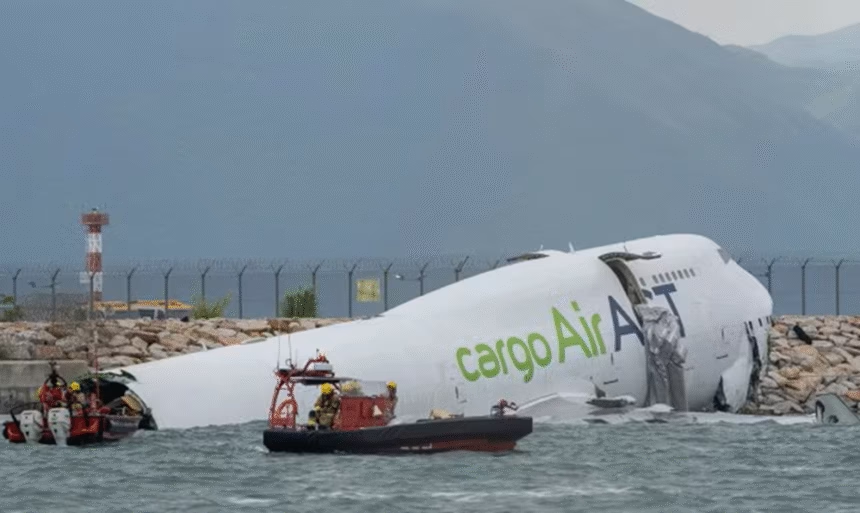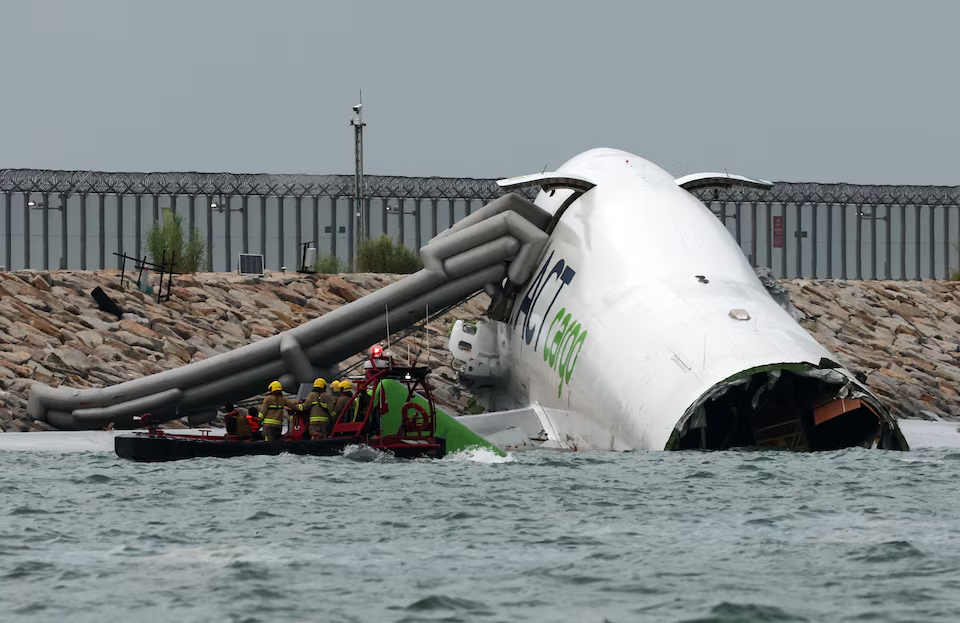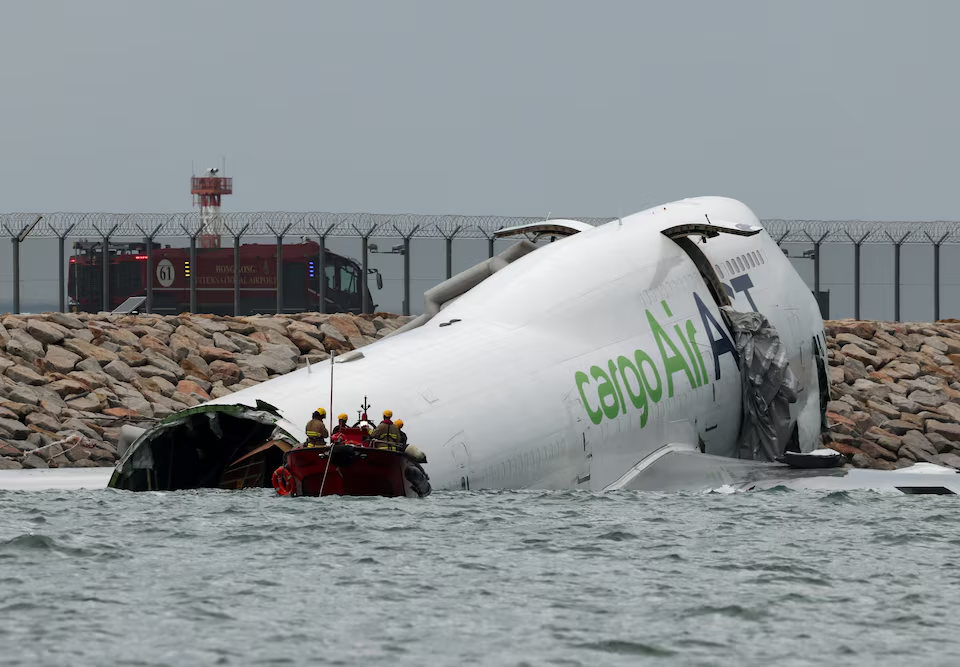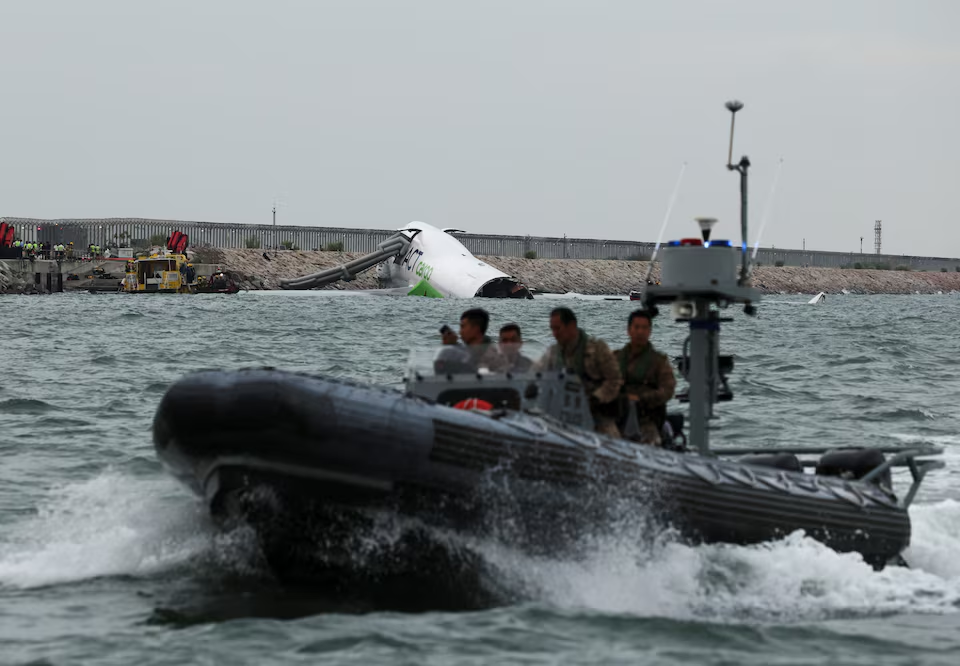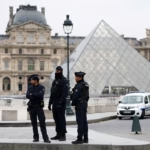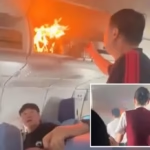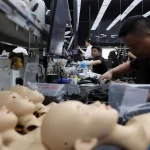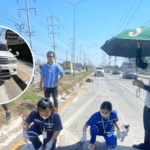HONG KONG – A routine cargo arrival at Hong Kong International Airport turned into a fatal crash before dawn, claiming the lives of two airport workers and leaving a Boeing 747-400 freighter half-submerged off the North Runway.
The Emirates SkyCargo flight, EK9788, operated by Atlas Air Cargo Transport (Air ACT) using a 747-400(BDSF), came in from Dubai’s Al Maktoum International Airport at about 3.50 am.
After touchdown on runway 07L/25R, the aircraft veered off course, struck a ground patrol vehicle, then broke through the perimeter and entered the shallow waters of the Pearl River Delta. The jet, registration TC-AFO, was carrying high-value electronics and perishables for Hong Kong’s cargo market.
Early-shift crew described a violent arrival. Several workers who were on break near the terminal heard a heavy impact and screeching on the runway. One baggage handler said the aircraft appeared to land hard, then swing left, clipping a patrol vehicle before it crossed the boundary. The collision hurled the pickup into the sea.
Flight-tracking data supports the timeline. The aircraft was recorded at about 90 knots, or 167 km/h, roughly 1,500 metres from touchdown. Soon after, the jet yawed left and travelled several thousand feet before it breached the airfield perimeter.
Patrol Vehicle Hit
The patrol vehicle was reportedly hit at about 49 knots. The aircraft’s nose now sits at an angle above the water line, with sections of fuselage and gear submerged. Metal fragments and loose cargo drifted in the shallows as emergency teams converged.
Airport Fire Service units, marine police, and Government Flying Service helicopters arrived within minutes. Floodlights lit the crash zone while crews worked from the seawall and from boats. Divers searched the water for the missing ground staff and assessed the aircraft’s position in the tidal flow.
The victims were named as Chan Siu-ling, 38, a logistics coordinator with the Airport Authority Hong Kong, and Leung Kwok-hung, 45, a ground patrol officer and father of three. Both had long service at the airport.
They were in a Toyota Hilux performing routine runway and taxiway checks before the morning push. Their vehicle fell about 20 metres into the water and submerged quickly. Divers from the Auxiliary Medical Service located both victims before dawn. Paramedics pronounced them dead at the scene.
The four-person flight crew survived. Captain Ahmed Khalil, 49, with around 15,000 hours, first officer Maria Santos, 32, and two loadmasters were winched out and flown to North Lantau Hospital. According to the attending doctor, Dr Eliza Fong, they suffered minor cuts and mild hypothermia from the water, but none had life-threatening injuries. Hospital staff described them as shaken yet stable.
Investigation Begins
By sunrise, the airport shifted into crisis mode. The North Runway closed, and 23 inbound flights were diverted to Shenzhen and Macau. Cargo operations slowed to a crawl. Passenger disruption was limited due to the early hour, yet freight schedules took a heavy hit.
Sensitive goods such as fresh produce and electronics risked delay, with logistics firms scrambling for alternatives. AAHK chief executive Fred Lam expressed condolences and said operations teams were working to stabilize the network. He added that the focus remained on families of the deceased and the safety of crews on the ground.
Investigators began work within hours. The weather did not appear to play a role. Visibility was about 10 kilometres, with light easterly winds near 5 knots. Early focus turned to possible technical faults in braking or steering systems, a tyre failure, or contamination on the runway. There were also unconfirmed reports of bird activity before arrival.
The Civil Aviation Department opened a joint probe with the Air Accident Investigation Authority, the U.S. National Transportation Safety Board, and Emirates safety staff. CAD director Alice Mak said a preliminary update would be released within 72 hours. The flight data recorder and cockpit voice recorder were both retrieved and will be analyzed.
The crash casts a shadow over an airport that prides itself on robust safety systems and high-volume cargo throughput. HKIA remains one of the world’s busiest freight hubs, handling millions of tonnes each year.
The airfield has invested heavily in runway upgrades, surface monitoring, and redundancy. Even so, recent years have brought a handful of close calls, including an A350 runway excursion in strong crosswinds. Veterans still recall the 1994 China Airlines accident near Lantau, a memory that lingers whenever a major incident occurs in the area.
Transport analysts noted that the North Runway has been under pressure throughout the expansion works. Traffic complexity, tight turnarounds, and dense cargo schedules raise the stakes for both flight crews and ground teams.
Hong Kong Families Mourn
Dr Vivian Tse of HKU said technology helps, but routine protection for those in patrol vehicles and on the apron matters just as much. She pointed to better vehicle shielding, clearer comms, and strict movement control as simple measures that save lives.
Families gathered near Tung Chung as word spread. Candles and white flowers appeared by midday. Chan’s husband held a photograph of their teenage daughter while speaking quietly to the media. He said his wife liked the early hours because the airfield felt calm at dawn.
Leung’s widow stood with trade union representatives from the Aviation Logistics Employees Association. They urged upgrades to patrol vehicles, improved runway sweeps, and stronger protocols for mixed traffic during live operations.
Emirates released a short statement from Dubai expressing sorrow and support for the families and all staff affected. Boeing dispatched technical teams from Seattle to assist investigators and the operator. AAHK said initial financial support of HK$2 million per family would be made available, with further assistance to follow. The Chief Executive, John Lee, called the move an urgent show of care while formal inquiries proceed.
Salvors brought in barges and cranes as the tide turned. Teams began stabilizing the jet to prevent further damage and to protect marine areas from fuel leaks. The priority was safety, both for the divers and for crews working near the fuselage. Engineers planned a staged lift, with cargo removal, fuel recovery, and section-by-section retraction from the water. Officials warned that the North Runway closure could last beyond the initial 24 hours, depending on progress.
While the South Runway kept traffic moving, the crash created a bottleneck across the region. Freight forwarders scrambled to reroute shipments through Guangzhou, Shenzhen, and Macau, while airlines reshuffled belly cargo on passenger services. Some perishable consignments were transferred to cold storage facilities, with priority slots allocated for onward flights once the runway reopens.
Attention now turns to the cause. Investigators will map tyre marks, runway friction, and the trail of debris. They will compare aircraft systems data with crew actions, tower recordings, and ground radar. They will review maintenance logs, cargo weight and balance, and any issues reported en route from Dubai. Any hint of foreign object debris, wildlife strike, or surface contamination will be checked against inspection records from the night shift.
The accident underscores an old truth in aviation. Many barriers must fail for a crash to occur. This one pierced several layers, from runway safety to airframe control and ground vehicle protection. The lessons will matter for airports with dense cargo schedules, mixed ground traffic, and complex runway works.
As the day wore on, contrails crossed the sky over Lantau while the wreck remained in the shallows. The city carried on, but with a heavier step. In a place built on speed and precision, the loss of two dedicated workers feels raw. The questions are clear. What went wrong on landing? How did a patrol vehicle end up in harm’s way, and what must change so crews return home safe after every shift?
When the preliminary report lands, answers will start to form. For now, Hong Kong mourns two colleagues who kept watch while others slept, and who paid the price when a routine arrival turned fatal.




